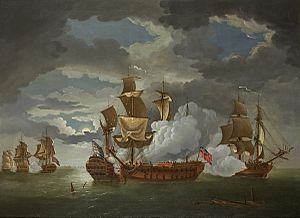HMS Serapis (1779) facts for kids

Defence of Captn Pearson in his Majesty’s Ship Serapis and the Countess of Scarborough Arm’d Ship Captn Piercy, against Paul Jones's Squadron, 23 September 1779, by Richard Paton.
|
|
Quick facts for kids History |
|
|---|---|
| Name | HMS Serapis |
| Ordered | 11 February 1778 |
| Builder | Randall & Brent, Rotherhithe |
| Laid down | 3 March 1778 |
| Launched | 4 March 1779 |
| Fate | Taken by American Bonhomme Richard, assisted by other vessels |
| Name | Serapis |
| Fate | Transferred to France |
| Name | Sérapis |
| Fate | Wrecked in 1781 off Madagascar |
| General characteristics | |
| Class and type | Roebuck-class fifth-rate ship |
| Tons burthen | 87926⁄94 (bm; as designed) |
| Length |
|
| Beam | 37 ft 9+1⁄2 in (12 m) |
| Depth of hold | 16 ft 4 in (5 m) |
| Sail plan | Full-rigged ship |
| Complement | 280 (300 from 1780) |
| Armament |
|
HMS Serapis was a British warship built in 1779. She was a "fifth-rate" ship, meaning she was a medium-sized warship with two decks of guns. The ship was named after Serapis, a god from Greek and Egyptian stories.
Serapis was built by Randall & Brent in Rotherhithe, England. She was armed with 44 cannons. These included twenty 18-pounder guns, twenty 9-pounder guns, and four 6-pounder guns. The "pounder" number tells you the weight of the cannonball the gun fired.
During the American War of Independence, American forces captured Serapis. They later gave her to the French. The French used her as a privateer, which was a private ship allowed to attack enemy ships. Sadly, Serapis was lost in 1781 off the coast of Madagascar due to a fire.
Contents
The Battle of Flamborough Head
In March 1779, Captain Richard Pearson took command of Serapis. On September 23, 1779, Serapis faced off against the American warship USS Bonhomme Richard. This famous battle happened in the North Sea near Flamborough Head, England. At this time, Serapis had 50 guns.
The two ships fired heavily at each other. The American ship, Bonhomme Richard, lost many of its guns. However, Captain John Paul Jones, who commanded Bonhomme Richard, managed to tie his ship to Serapis. This made it harder for Serapis to use its bigger guns.
During the battle, Captain Pearson asked Jones if he would surrender. Jones famously replied, "I have not yet begun to fight!" The fight continued for three hours. The crew of Bonhomme Richard fought bravely, firing into Serapis's deck.
Later, another American ship, USS Alliance, joined the fight. It began firing at both ships without caring which one it hit. Bonhomme Richard started to sink. Captain Pearson, unable to aim his guns at the new threat, finally surrendered. This meant Serapis was captured by the Americans.
What Happened Next?
After the battle, Captain Jones sailed Serapis to the neutral Dutch Republic. This caused some problems because the Dutch did not officially recognize the United States as a country yet. To avoid trouble, Jones secretly renamed his captured ship Serapis. An unofficial Serapis flag was used in Dutch records.
Even though the British ships lost the battle, they had successfully protected a very important group of merchant ships. Both Captain Pearson and the captain of the other British ship, HM Countess of Scarborough, were rewarded for their efforts.
Serapis and Countess of Scarborough were later officially declared as ships captured by the French.
The Loss of Serapis
Between October and December 1779, Serapis was in the Texel, a port in the Netherlands. By September 1780, she was likely in Lorient, France.
The French Royal Navy took control of Sérapis (as they called her). They loaned her to a civilian captain named Roche. He planned to use the ship to fight the British in the Indian Ocean.
On July 31, 1781, Sérapis was off the coast of Madagascar. The crew was trading goods like spirits and arak for rice. A crew member, L'Héritier, took candles out of their safe lanterns. The candles accidentally lit alcohol fumes in the ship's lower areas.
The crew fought the fire for two and a half hours. But the flames eventually reached a room where gunpowder was stored. The explosion that followed ripped off the back of the ship, causing her to sink. Eight men died, but 215 people survived. Another privateer ship, Daliram, took the survivors back to Île Sainte-Marie, Madagascar.
Finding the Wreck
In November 1999, two American underwater explorers, Richard Swete and Michael Tuttle, found the remains of Serapis. They located the shipwreck near Île Sainte-Marie in Madagascar.
See also

